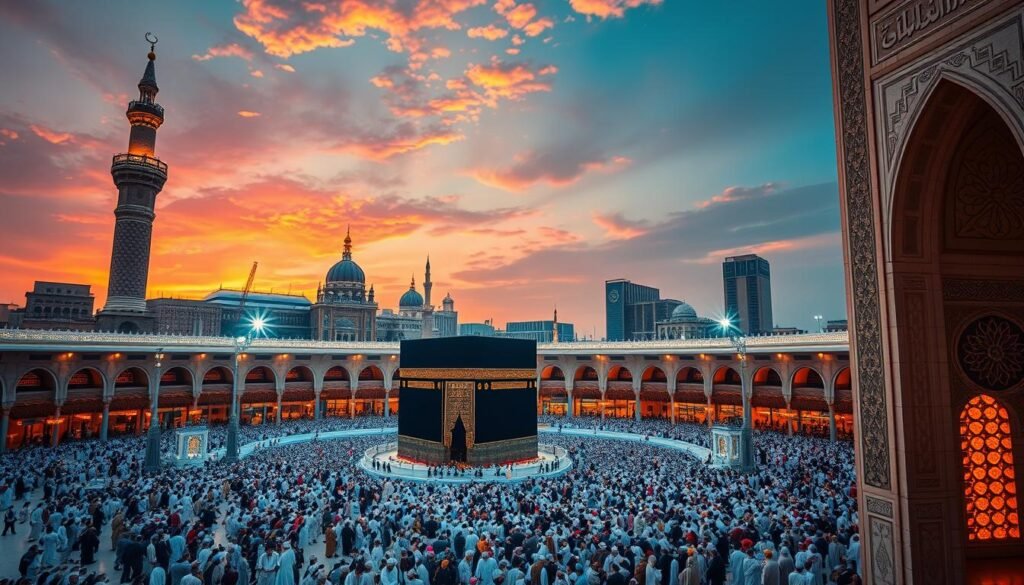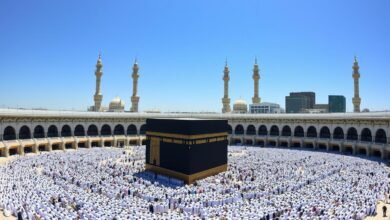Planning a Spiritual Trip to Saudi Arabia: Essential Tips

I’ve always been drawn to Saudi Arabia and its sacred Islamic sites. Planning a spiritual trip there can be both exciting and challenging. What rituals, protocols, or considerations should I know about? In this guide, I’ll share my insights and essential tips for a transformative journey to Saudi Arabia.
Understanding Mecca and Medina’s history and knowing visa rules and cultural norms are key. This article will give you the knowledge to plan an unforgettable spiritual adventure. Whether you’re on a pilgrimage or exploring the kingdom’s heritage, these tips will help make your experience deeply meaningful.
Understanding Saudi Arabia’s Sacred Significance
Saudi Arabia is deeply important in the Islamic world. It is home to Mecca and Medina, two holy sites. These cities are where the Prophet Muhammad was born and are the heart of Islam. They attract millions of religious tourists every year.
Historical Importance of Mecca and Medina
Mecca is the holiest city in Islam, where the Prophet Muhammad was born. It has the Kaaba, a key spot for Muslim prayers. Medina is where the Prophet is buried and has the Masjid al-Nabawi, a huge and important mosque. These Islamic holy sites are at the center of the Muslim world, shaping the faith for centuries.
The Role of Saudi Arabia in Islamic Heritage
Saudi Arabia is key in keeping the mecca and medina heritage alive. The government spends a lot to maintain and improve these sites. This effort makes sure pilgrims can visit and experience the Islamic legacy. Saudi Arabia is highly respected in the Muslim world for this.
Major Religious Sites and Their Significance
- Masjid al-Haram (Grand Mosque) in Mecca: This is the largest and most important mosque in the world, housing the Kaaba at its center.
- Masjid al-Nabawi in Medina: This mosque was built by the Prophet Muhammad and is the second-holiest site in Islam, after the Masjid al-Haram.
- Mount Arafat: This is the site where the Prophet Muhammad delivered his final sermon, and it is a crucial part of the Hajj pilgrimage.
- Jabal an-Nour: This mountain is home to the Hira cave, where the Prophet Muhammad is believed to have received the first revelations of the Quran.
These and other religious tourism sites in Saudi Arabia are very important to Muslims. They make Saudi Arabia a true mecca and medina of the Islamic faith.
Visa Requirements and Documentation Process
Planning a trip to Saudi Arabia for spiritual reasons needs careful steps. First, you must understand the visa requirements. As a Muslim traveler, knowing the different religious visas, needed documents, and application time is key.
Types of Religious Visas Available
Saudi Arabia has two main religious visas. The Hajj visa is for the annual Islamic pilgrimage. The Umrah visa is for visits to Mecca and Medina any time of the year.
Required Documents and Paperwork
- A valid passport with at least 6 months of remaining validity
- A completed visa application form
- A copy of your travel itinerary or flight booking
- Proof of financial means to cover your expenses during the trip
- A medical certificate indicating your fitness for travel
- Proof of your Islamic faith, such as a letter from your local mosque
Application Timeline and Procedures
The visa application process takes several weeks. So, it’s important to plan early. For Hajj, apply a few months before. Umrah visas are available all year. Apply well in advance to ensure approval.
Understanding visa requirements and the application process ensures a smooth trip. Plan ahead to make the most of your journey to Saudi Arabia’s holy sites. Stay informed and plan well to follow your Muslim travel guide.
Choosing Between Hajj and Umrah Pilgrimages
Planning a spiritual trip to Saudi Arabia means deciding between the hajj and umrah pilgrimages. Both journeys are deeply meaningful but have different requirements and procedures.
Understanding Hajj Requirements
The hajj is a mandatory duty for all able-bodied Muslims who can afford it. It involves specific rituals in Mecca’s sacred mosques during Dhul-Hijjah. You must wear special clothing and follow strict protocols for several days.
Umrah Guidelines and Procedures
The umrah is a voluntary pilgrimage that can be done anytime. It’s a shorter journey to Mecca and Medina’s mosques. Though it lacks the hajj’s mandatory rituals, it’s still very spiritual for Muslim travelers.
Seasonal Considerations
The timing of your trip affects your choice between hajj and umrah. Hajj happens in a specific period, while umrah can be done any time. Seasons like Ramadan might be busier or have different rules for both pilgrimages.
| Hajj Pilgrimage | Umrah Pilgrimage |
|---|---|
| Mandatory for able-bodied Muslims | Voluntary for Muslims |
| Specific rituals and activities during Dhul-Hijjah | Flexible schedule, can be performed year-round |
| Larger crowds and more restrictive requirements | Smaller crowds and more flexible guidelines |
Your choice between hajj and umrah depends on your personal and religious needs. Knowing the differences helps you choose the best journey for your spiritual trip to Saudi Arabia.
Accommodation Options Near Holy Sites
Planning a spiritual trip to Saudi Arabia means finding the right place to stay. There are many choices for every budget and preference.
For a top-notch stay, five-star hotels in Mecca and Medina are the best. They offer luxury and are close to the mosques. These hotels have private prayer rooms, halal food, and shuttle services.
If you’re watching your budget, there are cheaper options. Mid-range hotels, guest houses, and hostels are available. They are close to the holy sites and offer a comfortable stay.
For a unique experience, try a traditional Arabian inn, or riad. They are in the historic parts of the cities. These places show local life and have beautiful courtyards and architecture.
It’s important to book early, especially during busy times. This way, you get the best spot and amenities. Researching and comparing helps find the perfect place for your trip to Saudi Arabia.

Transportation and Movement Guidelines
Traveling in Saudi Arabia’s sacred sites can seem hard, but planning helps. Knowing how to get around Mecca and other key places is crucial. It makes your spiritual journey smoother and more enjoyable.
Getting Around in Mecca
Mecca, the holiest city in Islam, gets very crowded, especially during peak times. The city has buses and taxis that are reliable and cheap. But, it’s important to know the system well and plan your trips ahead to save time.
Transportation Between Sacred Sites
Important religious sites like Medina and Jeddah are just a few hours from Mecca. Renting a car or using private shuttles is the best way to get there. If you’re on a tight budget, intercity buses are a good choice.
Local Transport Tips
- Learn about local transport apps and maps to plan your trips well.
- Think about hiring a private driver or using ride-sharing, especially for big groups or lots of luggage.
- Watch out for heavy traffic, especially during busy times, and plan to arrive early.
- Stay alert and follow local traffic rules to ensure a safe trip.
Knowing how to get around in Saudi Arabia lets you focus on the spiritual side of your trip. You’ll make the most of your time in this amazing country.
Dress Code and Cultural Etiquette
When you travel to Saudi Arabia’s islamic holy sites, it’s important to follow the local customs and dress code. This shows respect for the sacred places and helps you blend in with the culture.
Modest Attire for Men
- Cover your body from shoulders to knees, avoiding shorts or sleeveless shirts.
- Wear loose, flowing garments that conceal your shape.
- Choose lightweight, breathable fabrics to stay cool in the warm weather.
Appropriate Dress for Women
- Cover your head, arms, and legs completely, wearing an abaya (long, loose-fitting cloak) and a headscarf.
- Avoid form-fitting or revealing clothing that could be considered immodest.
- Bring comfortable, closed-toe shoes to navigate the holy sites.
General Cultural Etiquette
- Avoid public displays of affection, as they are considered inappropriate.
- Speak softly and refrain from loud conversations, especially near prayer areas.
- Remove your shoes before entering mosques and other sacred spaces.
- Respect the privacy and personal space of others, particularly during prayer times.
Following these dress and cultural guidelines ensures a respectful and meaningful spiritual journey through Saudi Arabia’s muslim travel guide destinations. Your respect for local customs will make your experience better and deepen your connection with the country’s Islamic heritage.
| Dress Code | Men | Women |
|---|---|---|
| Head Coverage | Not Required | Head Scarf Mandatory |
| Body Coverage | Shoulders to Knees | Entire Body, Excluding Face and Hands |
| Fabric | Loose, Breathable | Loose, Concealing |
| Footwear | Closed-Toe | Closed-Toe |

Health Preparations and Medical Requirements
Going on a spiritual journey to Saudi Arabia needs careful health planning. You’ll want to make sure you’re safe and comfortable. This includes getting the right vaccinations and having health insurance.
Required Vaccinations
All travelers to Saudi Arabia must show proof of certain vaccinations. These are:
- Meningococcal meningitis vaccine (quadrivalent ACYW-135 vaccine)
- Polio vaccine (for those traveling from polio-endemic countries)
- Seasonal influenza vaccine (strongly recommended)
Health Insurance Coverage
Having good health insurance is key for travel to Saudi Arabia. Your policy should cover emergencies, hospital stays, and getting you back home. It’s important to find a plan that meets Saudi Arabia’s requirements for religious travelers.
Emergency Medical Services
If you need medical help in Saudi Arabia, don’t worry. The country has a strong emergency medical system. Hospitals near Mecca and Medina can handle many health issues. Emergency teams are ready to help pilgrims in trouble.
| Required Vaccination | Purpose |
|---|---|
| Meningococcal meningitis vaccine | Protects against a potentially life-threatening bacterial infection |
| Polio vaccine | Prevents the spread of polio, a highly contagious viral disease |
| Seasonal influenza vaccine | Reduces the risk of contracting the flu during the pilgrimage |
Essential Items to Pack
Going on a spiritual trip to Saudi Arabia means you need to pack smart. Make sure you have everything you need for a great trip. This list will help you pack right and avoid any hassle.
Religious Items Checklist
When you visit Mecca and Medina, you’ll need the right clothes and accessories. You’ll need a Ihram, a special white garment for the Hajj or Umrah. Also, bring a prayer rug, a Quran, and a rosary for your spiritual practices.
Practical Necessities
But there’s more to pack than just religious items. You’ll want comfortable shoes, a hat or scarf for sun protection, and a water bottle. Don’t forget your medications, sunscreen, and personal care items.
Restricted Items
Remember, some items are not allowed in Saudi Arabia. This includes alcohol, pork, and non-Islamic religious items. Knowing what’s not allowed helps you respect local customs and have a smooth trip.
FAQ
What are the essential tips for planning a spiritual trip to Saudi Arabia?
Planning a spiritual trip to Saudi Arabia is crucial. It’s important to understand the holy sites’ significance. You also need to know about visa requirements and cultural etiquette.
What is the historical importance of Mecca and Medina in Islam?
Mecca and Medina are key for Muslims. Mecca is where the Prophet Muhammad was born and the Kaaba is located. Medina is where the Prophet Muhammad established the first Islamic community.
What types of religious visas are available for travel to Saudi Arabia?
Saudi Arabia offers two main religious visas. The Hajj visa is for the annual pilgrimage. The Umrah visa allows visits to the holy sites any time of the year.
What are the key differences between the Hajj and Umrah pilgrimages?
The Hajj and Umrah are both important pilgrimages. But, the Hajj is required once in a lifetime. The Umrah can be done anytime. The Hajj has specific rituals, like wearing Ihram and performing Tawaf.
What accommodation options are available near the holy sites in Saudi Arabia?
Near the holy sites, you can find many places to stay. Options range from hostels to luxury hotels. Choose based on location, amenities, and budget.
How can I navigate transportation and movement within Saudi Arabia?
Transportation in Saudi Arabia needs planning, especially around holy sites. In Mecca, personal vehicles are limited. Use buses and taxis to get around. Knowing these options helps you explore comfortably.
What is the appropriate dress code and cultural etiquette for visitors to Saudi Arabia’s holy sites?
Respecting local customs is key at Saudi Arabia’s holy sites. Dress modestly and avoid revealing clothes. Also, be mindful of cultural norms, like not showing affection in public.
What health preparations and medical requirements should I consider for my spiritual trip to Saudi Arabia?
Health is important for your trip to Saudi Arabia. Get necessary vaccinations and travel health insurance. Know the emergency medical services available.
What are the essential items I should pack for my spiritual trip to Saudi Arabia?
Packing for Saudi Arabia requires thought. Bring comfortable clothes and hygiene items. Don’t forget religious items and know what’s restricted.




